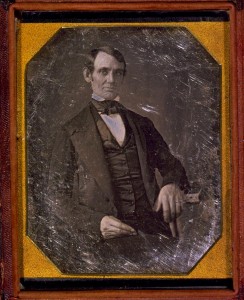All of this talk about daguerreotypes may leave you wondering about what the big deal is. So I just thought that I should pause for a few moments and reflect on the sheer magic of these little silvered copper plates. They are truly magical, or at least as magical as things get in this age of science and high technology. And, of course, part of their mystery resides in the way that they, as the original photographic medium, blend science, art, and seeming sorcery.
If you haven’t already done so, you really should experience them first hand. They are still “affordable” at antique stores. A lot of what are labeled to be daguerreotypes are, in fact, tin types. There’s a simple way to recognize them. The image seems to hang in space. You cannot quite place it as being on the surface. If you move your head slowly over a daguerreotype, you will see that just when you view it head on, it disappears, replaced by a shiny silver mirror like reflection. Indeed, in the day of daguerreotypes special boxes were constructed for viewing them.
Many of the people who made daguerreotypes were truly artists. As a result many of these images are beautifully and delicately hand-colored. The cases are special in and of themselves. These, often referred to as being made of gutta percha, a natural latex product, are in fact mislabeled. While manufactured in the nineteenth century they are created of the world’s first true thermoplastic.

Figure 1 – Daguerreotype of Abraham Lincoln in 1846 attributed to Nicholas H. Shepherd. In the LOC and in the public domain.
As I have said before, part of the charm is that captured in that ethereal daguerreotype image is a person from the mid nineteenth century. Often these are famous people, whom you never expected to see in a photograph. But more often, they are just everyday people, now long gone. There are even post mortem images, where the photographer was called upon to capture a last memory of a loved one.
I have categorized today’s blog both as “Reviews and Critiques” and “Personal Photographic Wanderings.” This is because viewing a daguerreotype is a highly intimate and personal experience. You have to experience them for yourself. They can affect you in so many different ways.
And finally, I know that many of you, including myself, have flocked or plan to flock to see Daniel Day-Lewis, as Lincoln, in Steven Spielberg’s new movie by that name. So if you have wondered what Lincoln actually looked like, I offer you the image of Figure 1, a daguerreotype taken in 1846 by the great American daguerreotypist Nicholas H. Shepherd.
